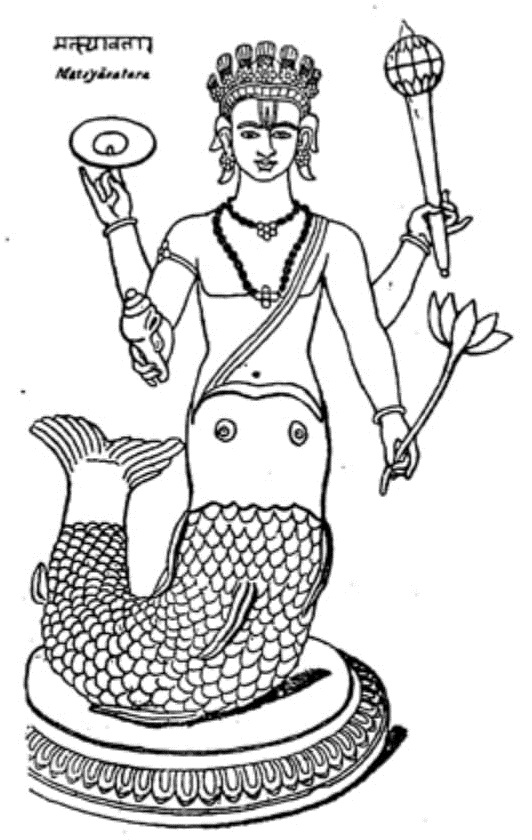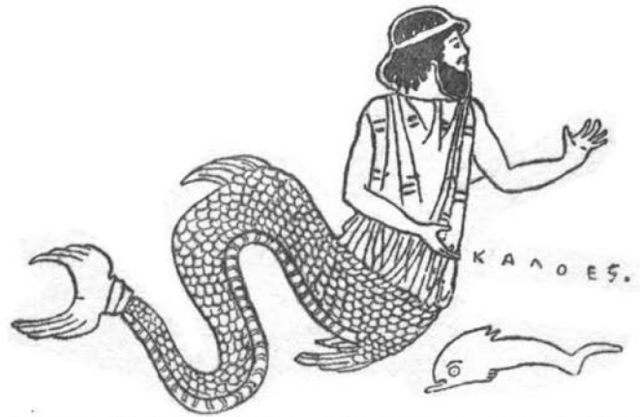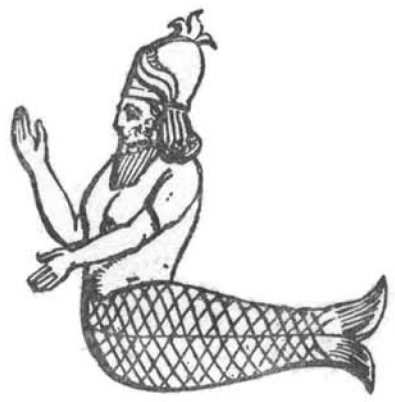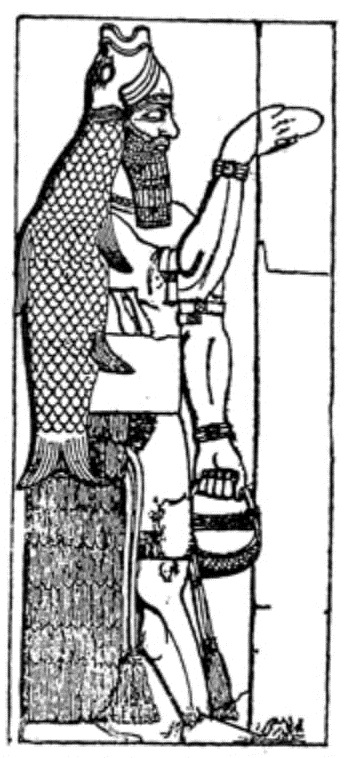
| VISHNU AND SUKHA AS HEAVEN 21. Vishnu and Sukha as Heaven :
According to Lieutenant Colonel Laurence Austine Waddell :
The Indo-Sumerian Seals Deciphered (1925) :
"The Fish of the Setting Sun" is for invocation for Resurrection from the Dead and its pictorial representation is found on ancient Sumerian and Hitto-Phoenician sacred seals and on Ancient Briton monuments are of great importance as they establish and confirm the evidence of these Indo-Sumerian seals.
This Sumerian "Fish" title for the Sun-god on this and the other amulet seals as "Fish of the Setting Sun (S'ukha)" is of the utmost critical importance for establishing the Sumerian origin of the Indo-Aryans and the Aryan character of the Sumerian language as it discloses for the first time the origin and until now unknown real meaning of the Vedic name for the Sun-god "Vishnu" and of his representative as a Fish-man as well as the Sumerian origin of the English word "Fish" the Gothic "Fisk" and Latin "Piscis."
The first "incarnation" of the Sun-god Vishnu in Indian mythology is represented as a Fish-man (see Fig. 19), and in substantially the same form as the Sumerian Fish-man personification of the Sun-god of the Waters in the Sumerian seals.
Fig. 19 : Sumerian Sun-Fish as Indian Sun-god Vishnu From an eighteenth-century Indian image (alter Moor's Hindoo Pantheon). Note : the Sun-Cross pendant on his necklace. He is given four arms to carry his emblems: (a) Disc of the Fiery Wheel (weapon) of the Sun, (61 Club or Stone-mace (Gada or Kaumo-daki) of the Sky-god Varuna, (c) Conch-shell (Shankh), trumpet of the Sea-Serpent demon (d) Lotus (Padma) as Sun-flower.
(1. Significantly this word "Kaumo-dakI" seems to be the Sumerian Qum, "to kill or crush to pieces" (B., 4173; B.W.. 193) and Dak or Daggu "a cut stone" (B., 5221, 5223).
2. "Protector of the S'ankha (or Conch)" is the title of the first and greatest Sea-Serpent king in Buddhist myth, see my List of Naga (or Sea-Serpent) Kings in Jour. Roy. Asial. Soc., Jan. 1894.
3. On the Lotus as symbol of heavenly birth, see my W.B.T., 338,381, 388.)
Now the Sumerians of Mesopotamia called the Setting Sun "The Fish (Kha)" a fact which has not until now been remarked or recognized. And this Sumerian title of "Fish" for the Sun is explained in the bilingual (two languages) Sumero-Akkadian glossaries by the actual word occurring in this and the other Indo-Sumerian amulets namely S'u-kha with the addition of "man" (na) by word-signs which read literally "The Winged Fish-man" thus co-relating the Winged or soaring Sun with the Fish personification of the supposed thus the "returning or resurrecting" from the water under the earth.
This solar title of "The Winged Fish" is further given the synonym of "The turning Bi i-i-es'" which latter name is evidently a variant spelling of the Sumerian Pi-es' or Pish for "Great Fish" with the pictograph word-sign of Fish joined to sign "great." This now discloses the Sumerian origin not only of the "Vish" in Vish-nu, but also of the English "Fish," Latin "Piscis," etc. the labials B, P, F and V being freely interchangeable in the Aryan family of languages.
The affix nu in "Vish-nu" is obviously the Sumerian Nu title of the water form of the Sun-god S'amas and of his father-god la or In-duru (Indra) as "God of the Deep". ‘It literally defines them as "The lying down, reclining or bedded" (god) or "drawer or pourer out of water".
It thus explains the common Indian representation of Vishnu as reclining upon the Serpent of the Deep amidst the Waters and also seems to disclose the Sumerian origin of the Ancient Egyptian name Nu for the "God of the Deep". Thus the name "Vish-nu" is seen to be the equivalent of the Sumerian Pish-nu and to mean "The reclining Great Fish(-god) of the Waters" and it will doubtless be found in that full form in Sumerian when searched for. And it would seem that this early "Fish" epithet of Vishnu for his "first incarnation" continued to be applied by the Indian Brahmans to that Sun-god even in his later "incarnations" as the "striding" Sun-god in the heavens. Indeed the Sumerian root Pish or Pis for "Great Fish" still survives in Sanskrit as Fts-ara "fish."
FIG. 20 : Posedion of the Greeks as the Sumerian Sun-Fish god Pis or Beiesh From Greek vase painting of filth century B.C. This Fish-man form of the Sumerian Sun-god of the Waters of the Deep, Piesh, Pish or Pis (or Vish-nu), also appears to disclose the unknown origin of the name of the Greek Sea-god "Pose idon" the Neptune of the Romans (see Fig. 20). That name now seems to mean "The Likeness (eidon) of Pos "i.e. Pis or Piesh" "The Great Fish" and thus discloses the derivation of that Greek name and myth from the Sumerian.
Moreover, the second part of that Greek name eidon as well as its cognates in the Aryan family of languages are also clearly derived from the Sumerian. In Sumerian Bi-ad = "see, look, form". Now in Early Greek eidon is spelt Fid-on, "see or look" and is cognate with the Latin Vid-eo, the Sanskrit Vid or Ved, "know" Gothic Vit and English "to wit" and "witness" and thus again is disclosed the Sumerian origin of Aryan words.
FIG. 21 : Vishnu as Sun-Fish man (S'ukha or Biesh) in Assyrio-Babylonian monuments. (After Layard) Further and complete identification of this Sumerian solar divinity or angel of Induru (Indra), "The Setting Sun-Fish" with Vishnu is in the Sumerian tradition which connotes "Three" and "Steps" with the Winged Sun-Fish and "The Great Fish" and thus discloses the Sumerian origin of the Indian Vedic tradition frequently referred to that Vishnu takes "Three Steps."
In the Sumerian definition of the Setting Sun as a "Fish" we find the Sun described as "The Stepping Fish-man and S'ukha or "The Winged Fish" which is defined as"Bi-i-i-esh" which is varient of spelling Pi-esh or Pish or "Great Fish" and its secondary meaning is Three. Presumably group of fish and three was early primitive expression for "a large number".
These "Three Steps" of the Sun-god Vishnu are thus seen to be the three steps or stages of the Sun’s supposed daily progress :
(1. Upwards from the horizon of sunrise to the zenith,
2.
Downwards from the zenith to sunset and,
Fig. 22 : Sun-Fish-man (S'ukha or Blesh) bestowing the ambrosia of Resurrection and Life, in Assyrio-Babylonian monuments (After Layard) This now recovers unknown name of the common Assyrio-Babylonian images of the Fish-man divinity traversing the waters (Fig. 21), or carrying a basket and bestowing the Life-giving ambrosia of Resurrection (Fig. 22). On his name as the so-called "goddess Nina".
This Sun-Fish divinity of the Resurrection and the Life of the old Aryan gentiles (non jewish) seems also the source of the title "The Fish" applied to Christ by the early Christian fathers and his symbol as such is usually represented facing eastwards like the Sumerian and Hittite Sun-Fish-god.
"S'ukha" name for the Resurrecting Sun-Fish is apparently the Sumerian source of the Sanskrit name Sukha for "heaven" and for "the western paradise of the God of the Deep" (Varun) who is represented in Indian mythology as a Fish-man as in the Sumerian seals of this Sun-Fish, or as riding upon a Fish. This Resurrecting Sun-Fish name "S'ukha" seems also to disclose the Sumerian origin of word on Amulet "Sukha" as "Swaha" in Sanskrit used by Brahmin for invocation and in Buddhist Amulet.
Through the later dialectic dropping out of the k in the guttural (speech sound) kh of the kha, whereby Khatti became "Hatti" (or "Hitt-ite") and Khamurabi became "Hamurabi" and thus "S'u-kha" became "Shuha" and "Swaha."
The personal name Uggu equates fairly well with the Vedic Uccaih - "the famous" (Uccaih-shravas) sumamed Kaupayeya, who was a king of the Kurus, and a maternal uncle of the Panchcal or Phoenician prince Keshin Darbhya. The Kurus and Panchals are repeatedly referred to as kinsmen and allies under a joint king. This would explain the Gad or Kad title in the seal and this Gad or early Gothic personal name Uggu is probably the original of the latter Aryan personal name aspirated as "Hugo".
The Sumerian word-sign here for "grave," Gur or Khar, is defined as "box, receptacle, slay, lie down, dig," and thus seems to be the origin of our English word "grave." In the Akkadian the sign is called Khdra, also Kapru (pre sumably cognate with Kaparu, "cover, destroy"), and thus presumably the origin of the late Phoenician Khabr or Qabr "a grave" and the Gothic Kubl, and English "cover."
The definition of this Fish-House sign Kuad in the glossaries as "The cities (kiki) of the House of the Fish of the Sun" presumably relates to the numerous Phoenician cities called "Kad-esh" or "House of the Kad" evidently deriving their name from the sacred Fish of the Sun-temple therein as "The House of the Kuadi of the Sun". This also would explain why in late Syrio-Phoenician the word "Kadesh" means "holy".
This Sumerian name for "Fish" (Kha), with its sacred solar associations, although it has dropped out of use in Sanskrit as a term for "Fish" never- the less appears to survive in religious terms in Sanskrit, as Kha for "The Sun" "Heaven" and "Supreme Spirit" and as the unaspirated Ka, meaning "The Sun" and "Sun-god Vishnu." And it also accounts for the Indian Brahmanist tradition that long ago the Sun-god assumed the form of a Fish in the Fish incarnation of Vishnu, in which he subdued the Serpent of the Deep.
And it was presumably this ancient "pagan" Sun-Fish, the Piesh or Vishnu, which formed the legendary leviathan of the Deep called "Peishta Mor" or "The great Peishta", which St Patrick slew in Ireland.
And this Resurrecting Sun-Fish of the Sumerians and the "Dagon" of the Philistines was presumably the Aryan source of the symbol of a Fish for Christ, among the early Christians, a large proportion of whom were Syria-Phoenicians of Galilee of the Gentiles. And the destruction of its effigy by St Patrick was merely in series with the wholesale destruction of beautiful pre-Christian crosses by the early Church throughout the British Isles, merely because they were "pagan," or pre-Christian. And the Piscina or "Fish-bowl" built on the south side of the altar in old Christian churches in Britain and elsewhere is evidently a survival of the Sumero-Phcenician Fish shrine of this pagan "Sun-Fish of the Resurrection and the Life" invoked in these seals.
The
Sun-Fish of these seals is also called by Sumerians "The Fish
Lord of Bel", The Net of entry (to the Waters of Rebirth ?)
and under this title he is given the same explanatory title of "Na-pi-tub"
(or "Neptune") as before. The word for "net"
here is the same word which is used by the great Sumero-Phoenician
conqueror Bi(d)as'nadi (the Pasendi or Prasenjit of the Indian records
and the "Eannatum" of Assvriologists) the son of Mudgal
and grandson of Uruas'-the-Khad, in his celebrated monument of victory
generally called the "Stele of the Vultures" on account
of the vultures figured on it or carrying off the limbs of the dead
foes. In this, in reciting his treaty with the chief of his vanquished
enemies, "the men of Umma or Gishkhu he calls himself 'The
great Net of the Setting Sun and Rising Sun'" and repeats the
phrase several times and invokes the vengeance of the Net on those
who may break the treaty.
Other words for heaven :
Imin, the “Himin” is also known as Heaven by Eddie Goths and Hawk is symbol of Sun.
The Makers of Civilization in Race and History :
historical "Sumerian" or Aryan king Gaur or St George (Indra / Thor/ Adam) established Civilization, c. 3378 B.C., with the aid of his gallant son Prince Michael (Daksh) and his men in his first mountain capital in Cappadocia, called Imin or "Heaven," the Himin of the Goths, against these Devil-worshipping aborigines, still survives in the Gentile tradition incorporated in the Apocalypse. This is "the War of Heaven against the Devil and his angels," in which the historical Sumerian Prince Michael is seen to be the Archangel of Heaven who cast out "the great Dragon, that old Serpent called the Devil and Satan who deceiveth the whole world," in which the Devil is seen to be merely the totem of the cult of these Serpent-worshipping Chaldees who, with their Devil-priests, were ejected from the neighbourhood of the Aryan city-state.
Thus, we come to know the location of heaven which is first mountain capital in Cappadocia. |



